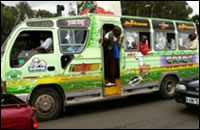Matatu Chaos in Nairobi: Police Are To Blame for Laxity

 |
| Only a few matatu operators are complying with the Michuki Rules |
It is noteworthy that three months after the promulgation of the Michuki Rules, road accidents declined nationally by 74% while accidents involving urban transport buses fell by a whooping 93%. This is no longer the case and every passenger or motorist will attest that only a few matatu operators are complying with the Michuki Rules. Consequently, disorder has crept back into the sector and new rules notwithstanding, public transport in the country is still bedeviled with incessant turmoil. The problem lies in enforcement rather than propriety of the law.
Legislative organs do not formulate law in vain and law is obeyed not because it has some mystic powers behind it, but because it is backed by the coercive machinery of the state. Uniformity, clarity and certainty are a hallmark of any good regulatory legislation. For some unknown reason, not every matatu operating in Eastlands adheres to the designated route or terminates at Muthurwa. It is this selective application of the City Council By-laws that has created two factions in the public transport sector in the City.
The Traffic Department of the Kenya police is conferred with the power to enforce these and other traffic laws. The Police have repeatedly featured in the top ten bracket of the Transparency International Bribery Index mainly due to corruption in the Traffic Department. Owing to this high level of corruption, lethargic indifference, selective application of the law and outright incompetence of the traffic police, the fairly lucrative public transport industry has over the years been invaded by cartels that have little regard for law and order, safety, comfort and the business interests of their clientele. These operators have over time become reckless merchants of death; licensed to kill and maim their own customers.
In a research carried out by the UK Transport Research Laboratory (TRRL), Kenya ranked fifth highest in the number of accidents per licensed vehicles out of 29 selected countries worldwide. The exchequer, the general public and private business pay heavy costs for the hospitalisation, treatment and rehabilitation of accident victims. They also bear the price of material damage to motor vehicles, mobile plant equipment, damaged merchandise and lost man hours. This is without counting the cost of fuel wasted in incessant traffic jams and the ever rising premiums of underwriting the high risks associated with public transport. This is all due to selective application and laxity in the enforcement of traffic laws.
It is high time the government adopted a scientific approach and implemented the recommendations of research and expert audit reports to find a lasting solution to the recurrent problems in the public transport sector. Experts recommend the creation of a composite structure where the general public, investors, industrial manufacturers, private motorists, insurers, the traffic police and other regulators as well as all other stakeholders are represented in the formulation, promulgation and enforcement of new traffic laws.
